Abstract
Vitamin D metabolites were studied in mother-infant pairs at delivery and eight and 15 weeks after that to evaluate the possibility of vitamin D supplementation of infant through the mother. Healthy mothers (n = 49) delivering in January received daily either 2000 IU (group 1), 1000 IU (group 2), or no (group 3) vitamin D. Their infants were exclusively breast fed, and those in group 3 received 400 IU of vitamin D a day. After eight weeks of lactation the infantile vitamin D concentrations were similar in groups 1 and 3 but significantly lower in group 2. The serum 24,25-dihydroxyvitamin D and 1,25-dihydroxyvitamin D concentrations were also lower in group 2. The mean mineral, parathyroid hormone, and alkaline phosphatase values showed no intergroup differences at any point. No infants showed any clinical or biochemical signs of rickets, and their growth was equal. In conclusion, a daily postpartum maternal supplementation with 2000 IU of vitamin D, but not with 1000 IU, seems to normalise the vitamin D metabolites of breast fed infants in winter. Maternal safety with such supplementation over prolonged periods, however, should be examined.
Full text
PDF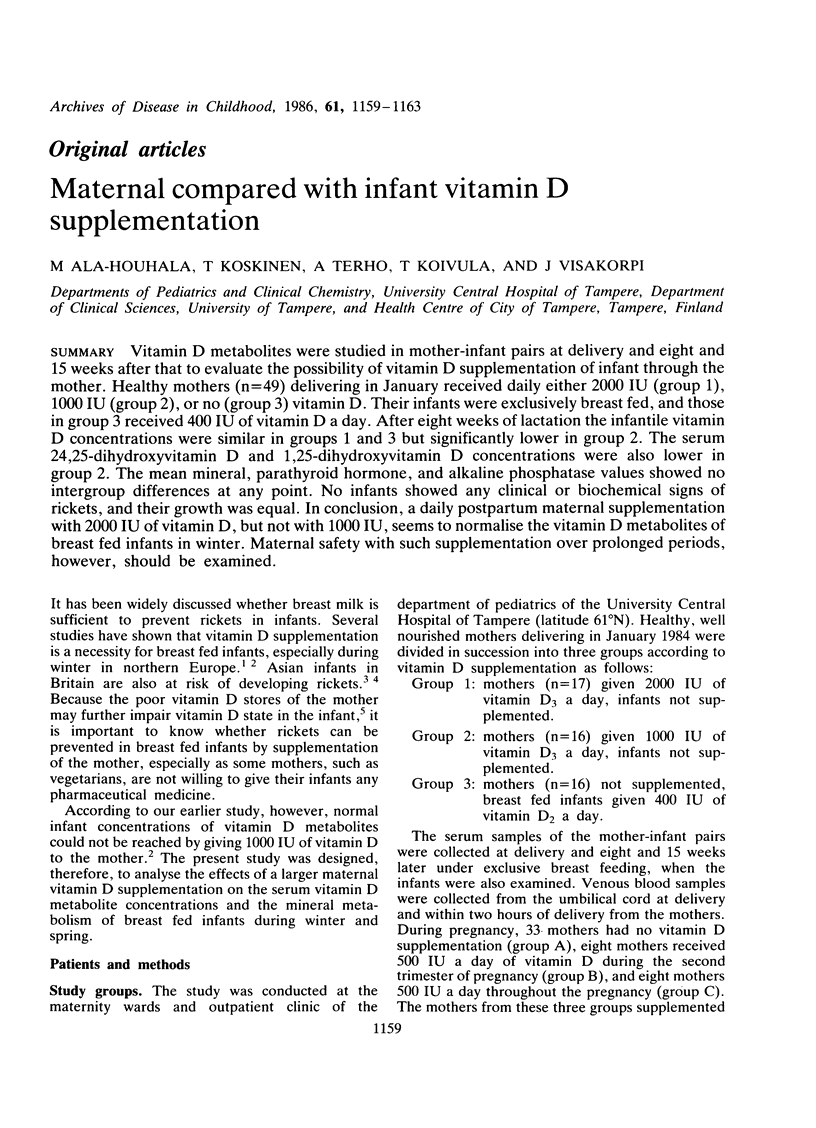
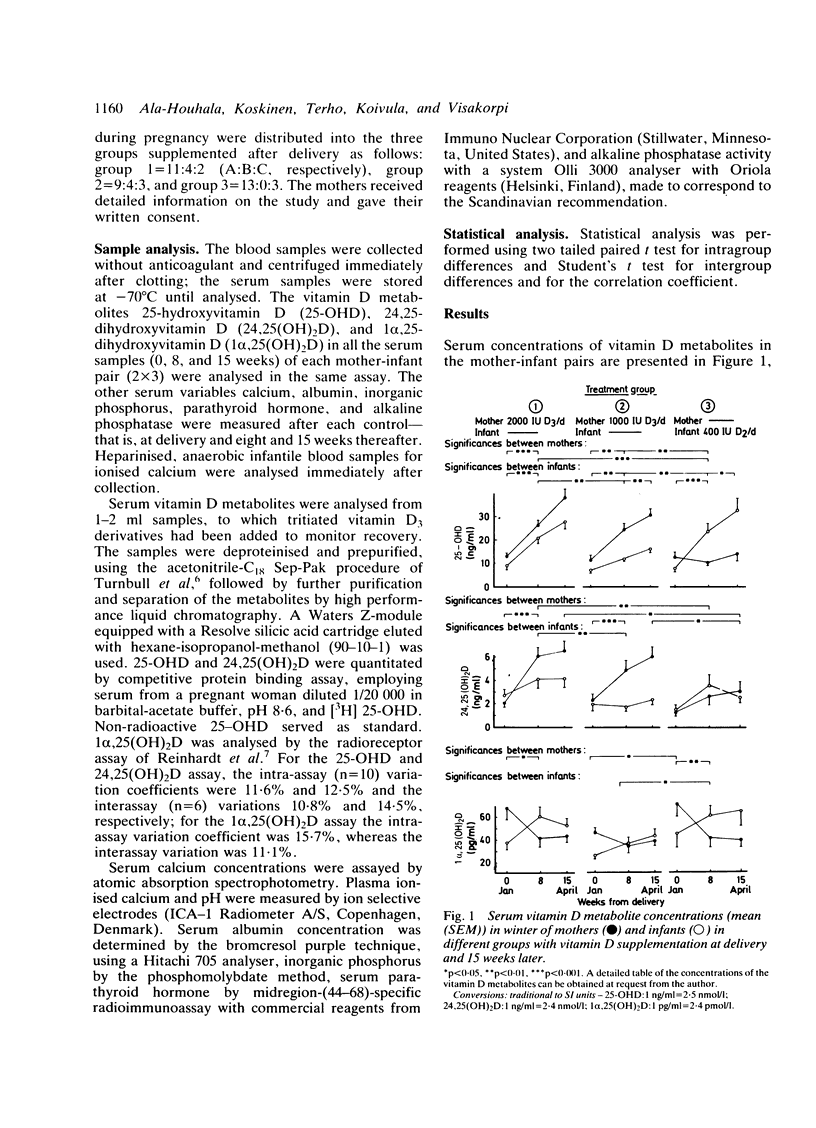
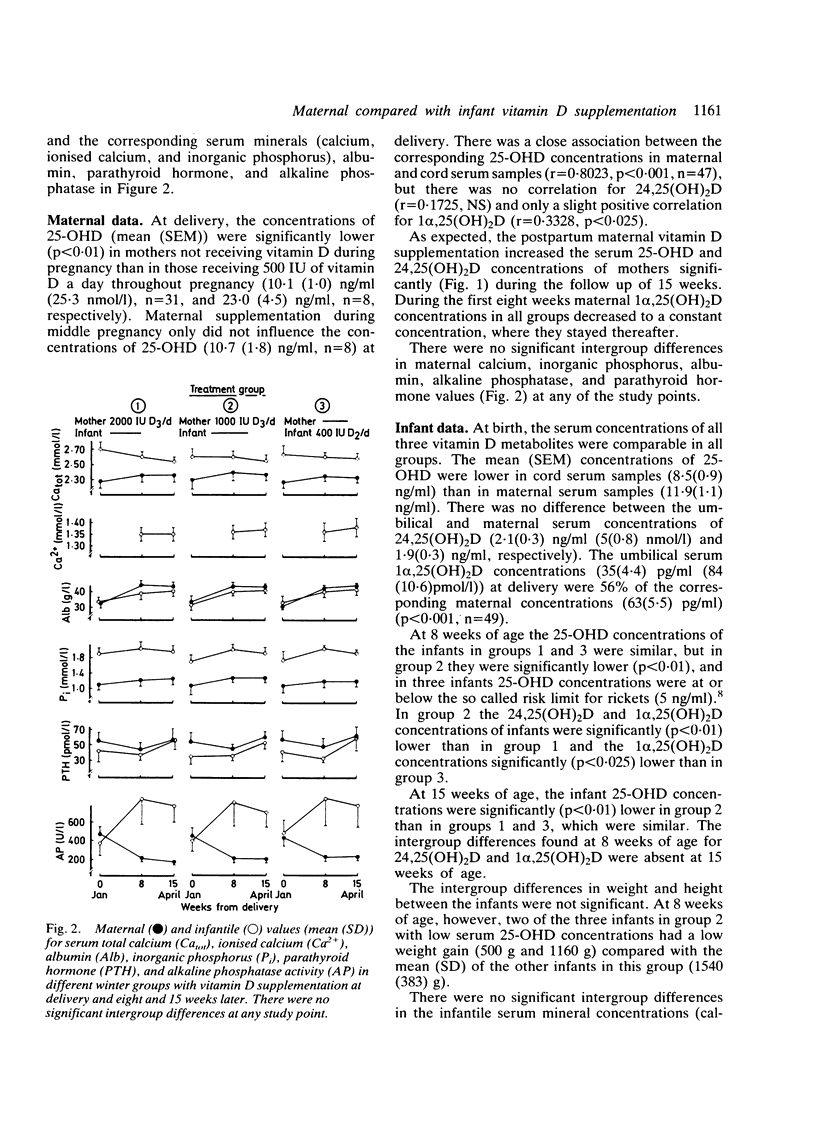
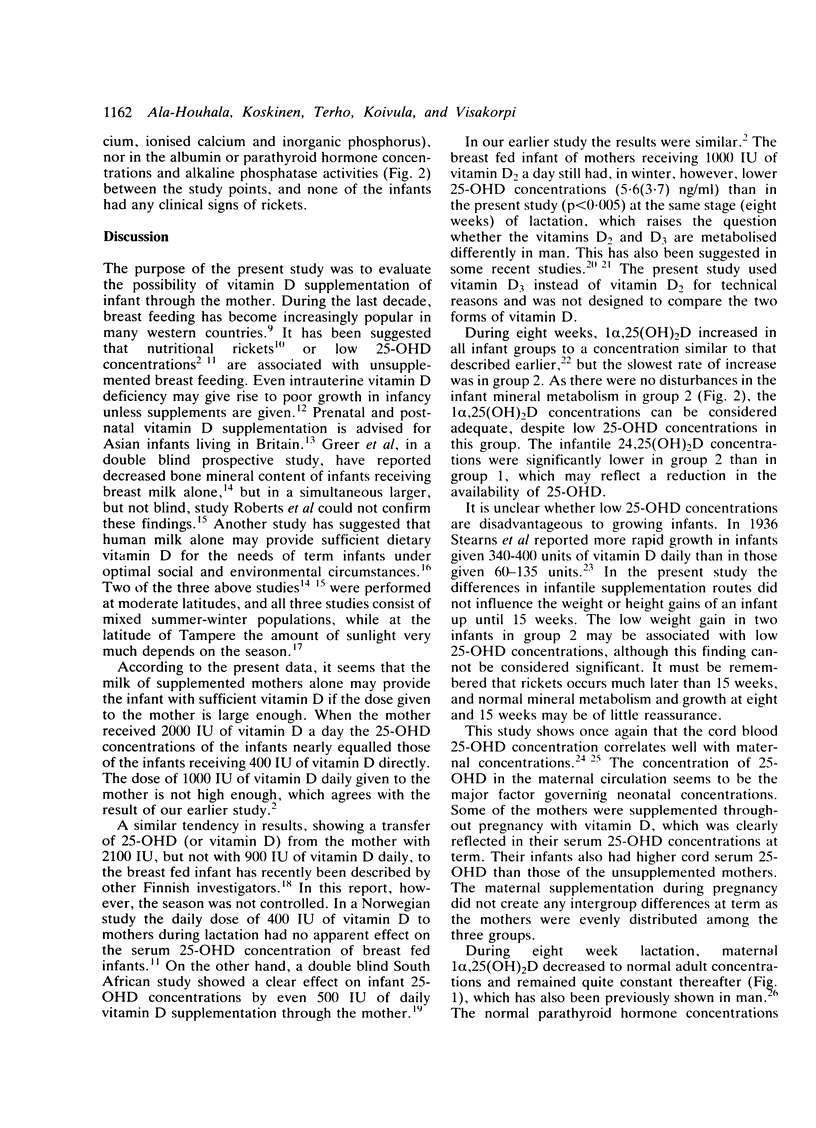
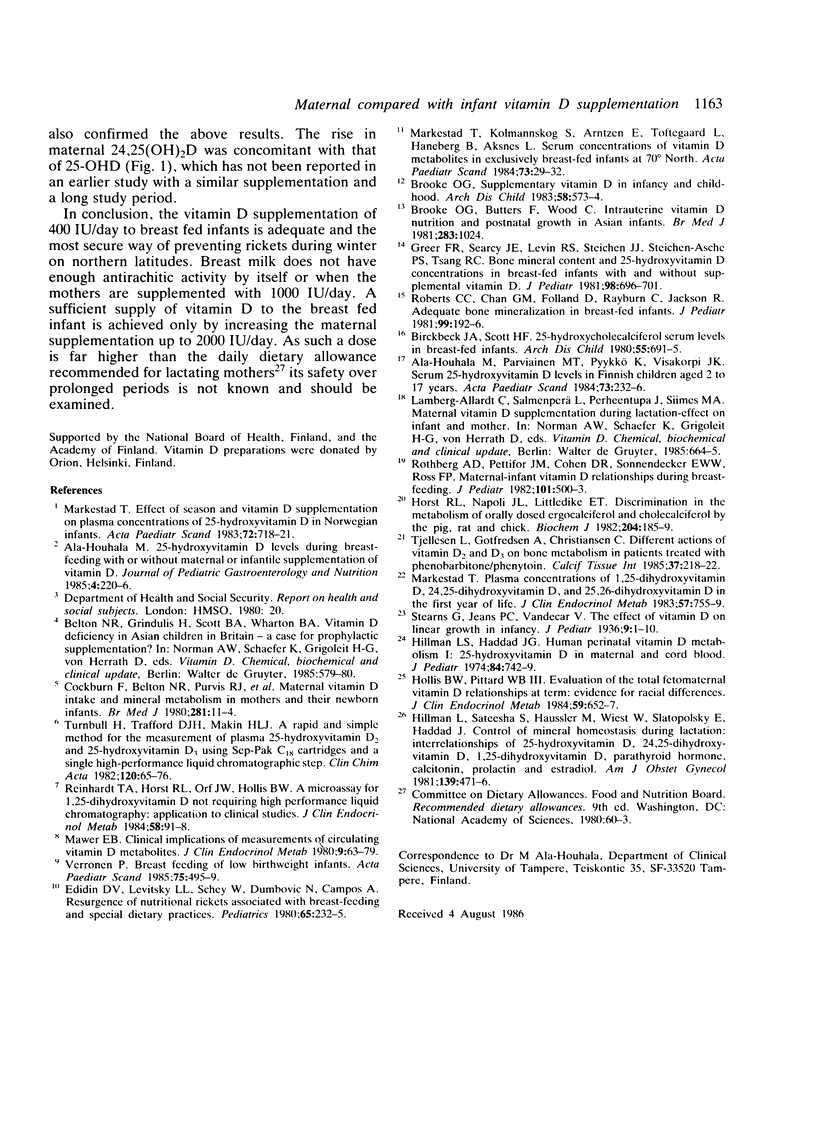
Selected References
These references are in PubMed. This may not be the complete list of references from this article.
- Ala-Houhala M. 25-Hydroxyvitamin D levels during breast-feeding with or without maternal or infantile supplementation of vitamin D. J Pediatr Gastroenterol Nutr. 1985 Apr;4(2):220–226. doi: 10.1097/00005176-198504000-00011. [DOI] [PubMed] [Google Scholar]
- Ala-Houhala M., Parviainen M. T., Pyykkö K., Visakorpi J. K. Serum 25-hydroxyvitamin D levels in Finnish children aged 2 to 17 years. Acta Paediatr Scand. 1984 Mar;73(2):232–236. doi: 10.1111/j.1651-2227.1984.tb09934.x. [DOI] [PubMed] [Google Scholar]
- Birkbeck J. A., Scott H. F. 25-Hydroxycholecalciferol serum levels in breast-fed infants. Arch Dis Child. 1980 Sep;55(9):691–695. doi: 10.1136/adc.55.9.691. [DOI] [PMC free article] [PubMed] [Google Scholar]
- Brooke O. G., Butters F., Wood C. Intrauterine vitamin D nutrition and postnatal growth in Asian infants. Br Med J (Clin Res Ed) 1981 Oct 17;283(6298):1024–1024. doi: 10.1136/bmj.283.6298.1024. [DOI] [PMC free article] [PubMed] [Google Scholar]
- Brooke O. G. Supplementary vitamin D in infancy and childhood. Arch Dis Child. 1983 Aug;58(8):573–574. doi: 10.1136/adc.58.8.573. [DOI] [PMC free article] [PubMed] [Google Scholar]
- Cockburn F., Belton N. R., Purvis R. J., Giles M. M., Brown J. K., Turner T. L., Wilkinson E. M., Forfar J. O., Barrie W. J., McKay G. S. Maternal vitamin D intake and mineral metabolism in mothers and their newborn infants. Br Med J. 1980 Jul 5;281(6232):11–14. doi: 10.1136/bmj.281.6232.11. [DOI] [PMC free article] [PubMed] [Google Scholar]
- Edidin D. V., Levitsky L. L., Schey W., Dumbovic N., Campos A. Resurgence of nutritional rickets associated with breast-feeding and special dietary practices. Pediatrics. 1980 Feb;65(2):232–235. [PubMed] [Google Scholar]
- Greer F. R., Searcy J. E., Levin R. S., Steichen J. J., Asch P. S., Tsang R. C. Bone mineral content and serum 25-hydroxyvitamin D concentration in breast-fed infants with and without supplemental vitamin D. J Pediatr. 1981 May;98(5):696–701. doi: 10.1016/s0022-3476(81)80827-x. [DOI] [PubMed] [Google Scholar]
- Hillman L. S., Haddad J. G. Human perinatal vitamin D metabolism. I. 25-Hydroxyvitamin D in maternal and cord blood. J Pediatr. 1974 May;84(5):742–749. doi: 10.1016/s0022-3476(74)80024-7. [DOI] [PubMed] [Google Scholar]
- Hillman L., Sateesha S., Haussler M., Wiest W., Slatopolsky E., Haddad J. Control of mineral homeostasis during lactation: interrelationships of 25-hydroxyvitamin D, 24,25-dihydroxyvitamin D, 1,25-dihydroxyvitamin D, parathyroid hormone, calcitonin, prolactin, and estradiol. Am J Obstet Gynecol. 1981 Feb 15;139(4):471–476. doi: 10.1016/0002-9378(81)90327-6. [DOI] [PubMed] [Google Scholar]
- Hollis B. W., Pittard W. B., 3rd Evaluation of the total fetomaternal vitamin D relationships at term: evidence for racial differences. J Clin Endocrinol Metab. 1984 Oct;59(4):652–657. doi: 10.1210/jcem-59-4-652. [DOI] [PubMed] [Google Scholar]
- Horst R. L., Napoli J. L., Littledike E. T. Discrimination in the metabolism of orally dosed ergocalciferol and cholecalciferol by the pig, rat and chick. Biochem J. 1982 Apr 15;204(1):185–189. doi: 10.1042/bj2040185. [DOI] [PMC free article] [PubMed] [Google Scholar]
- Markestad T., Kolmannskog S., Arntzen E., Toftegaard L., Haneberg B., Aksnes L. Serum concentrations of vitamin D metabolites in exclusively breast-fed infants at 70 degrees north. Acta Paediatr Scand. 1984 Jan;73(1):29–32. doi: 10.1111/j.1651-2227.1984.tb09893.x. [DOI] [PubMed] [Google Scholar]
- Markestad T. Plasma concentrations of 1,25-dihydroxyvitamin D, 24,25-dihydroxyvitamin D, and 25,26-dihydroxyvitamin D in the first year of life. J Clin Endocrinol Metab. 1983 Oct;57(4):755–759. doi: 10.1210/jcem-57-4-755. [DOI] [PubMed] [Google Scholar]
- Mawer E. B. Clinical implications of measurements of circulating vitamin D metabolites. Clin Endocrinol Metab. 1980 Mar;9(1):63–79. doi: 10.1016/s0300-595x(80)80021-1. [DOI] [PubMed] [Google Scholar]
- Reinhardt T. A., Horst R. L., Orf J. W., Hollis B. W. A microassay for 1,25-dihydroxyvitamin D not requiring high performance liquid chromatography: application to clinical studies. J Clin Endocrinol Metab. 1984 Jan;58(1):91–98. doi: 10.1210/jcem-58-1-91. [DOI] [PubMed] [Google Scholar]
- Roberts C. C., Chan G. M., Folland D., Rayburn C., Jackson R. Adequate bone mineralization in breast-fed infants. J Pediatr. 1981 Aug;99(2):192–196. doi: 10.1016/s0022-3476(81)80448-9. [DOI] [PubMed] [Google Scholar]
- Rothberg A. D., Pettifor J. M., Cohen D. F., Sonnendecker E. W., Ross F. P. Maternal-infant vitamin D relationships during breast-feeding. J Pediatr. 1982 Oct;101(4):500–503. doi: 10.1016/s0022-3476(82)80689-6. [DOI] [PubMed] [Google Scholar]
- Tjellesen L., Gotfredsen A., Christiansen C. Different actions of vitamin D2 and D3 on bone metabolism in patients treated with phenobarbitone/phenytoin. Calcif Tissue Int. 1985 May;37(3):218–222. doi: 10.1007/BF02554866. [DOI] [PubMed] [Google Scholar]
- Turnbull H., Trafford D. J., Makin H. L. A rapid and simple method for the measurement of plasma 25-hydroxyvitamin D2 and 25-hydroxyvitamin D3 using Sep-Pak C18 cartridges and a single high-performance liquid chromatographic step. Clin Chim Acta. 1982 Mar 26;120(1):65–76. doi: 10.1016/0009-8981(82)90078-x. [DOI] [PubMed] [Google Scholar]
- Verronen P. Breast feeding of low birthweight infants. Acta Paediatr Scand. 1985 Jul;74(4):495–499. doi: 10.1111/j.1651-2227.1985.tb11016.x. [DOI] [PubMed] [Google Scholar]


